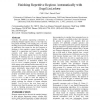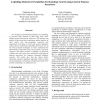524 search results - page 20 / 105 » Challenges of sequencing human genomes |
BIOCOMP
2006
13 years 10 months ago
2006
Currently, the genome sequencing community is producing shotgun sequence data at a very high rate, but genome finishing is not keeping pace, even with the help from several automa...
NAR
2006
13 years 8 months ago
2006
Recent work has demonstrated that microRNAs (miRNAs) are involved in critical biological processes by suppressing the translation of coding genes. This work develops an integrated...
BMCBI
2005
13 years 8 months ago
2005
Background: Enhancements in sequencing technology have recently yielded assemblies of large genomes including rat, mouse, human, fruit fly, and zebrafish. The availability of larg...
ICPADS
2005
IEEE
14 years 2 months ago
2005
IEEE
New biological experimental techniques are continuing to generate large amounts of data using DNA, RNA, human genome and protein sequences. The quantity and quality of data from t...
BMCBI
2004
13 years 8 months ago
2004
Background: In addition to known protein-coding genes, large amounts of apparently non-coding sequence are conserved between the human and mouse genomes. It seems reasonable to as...


